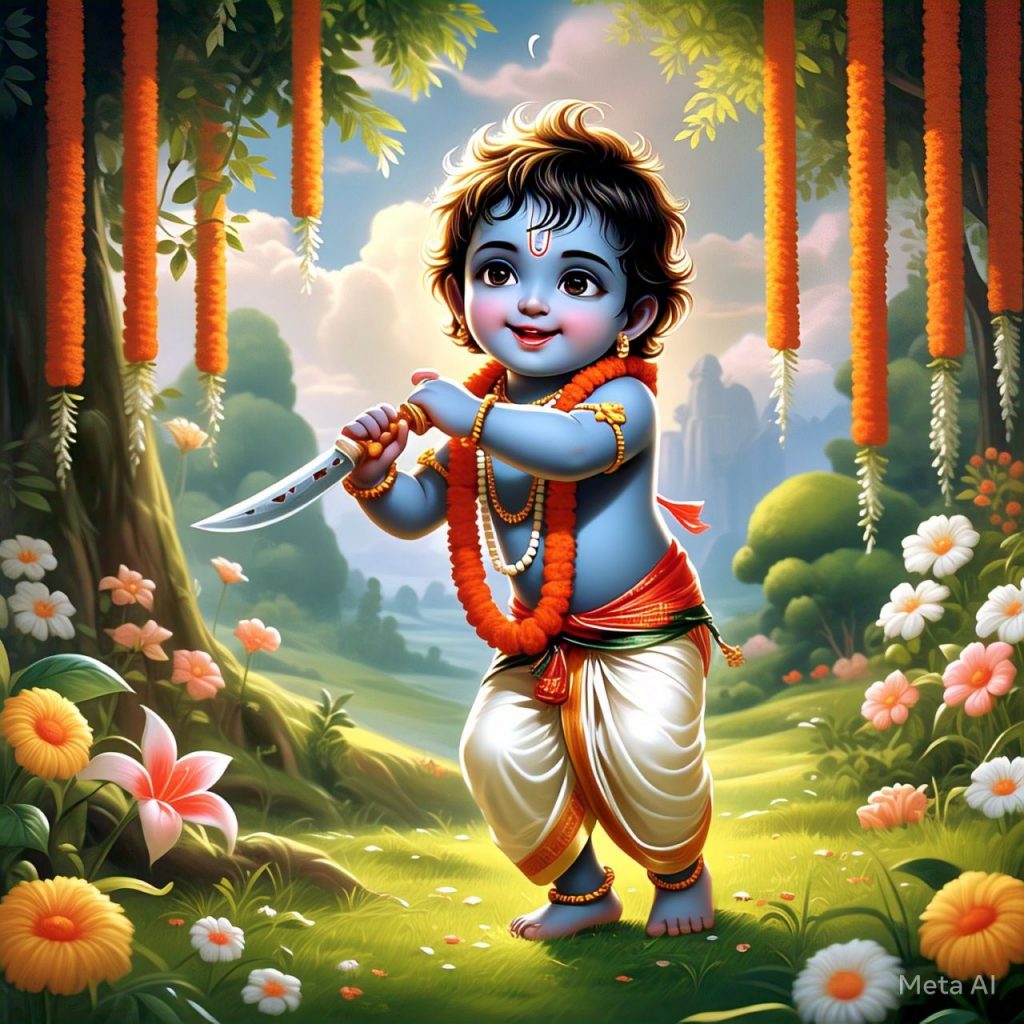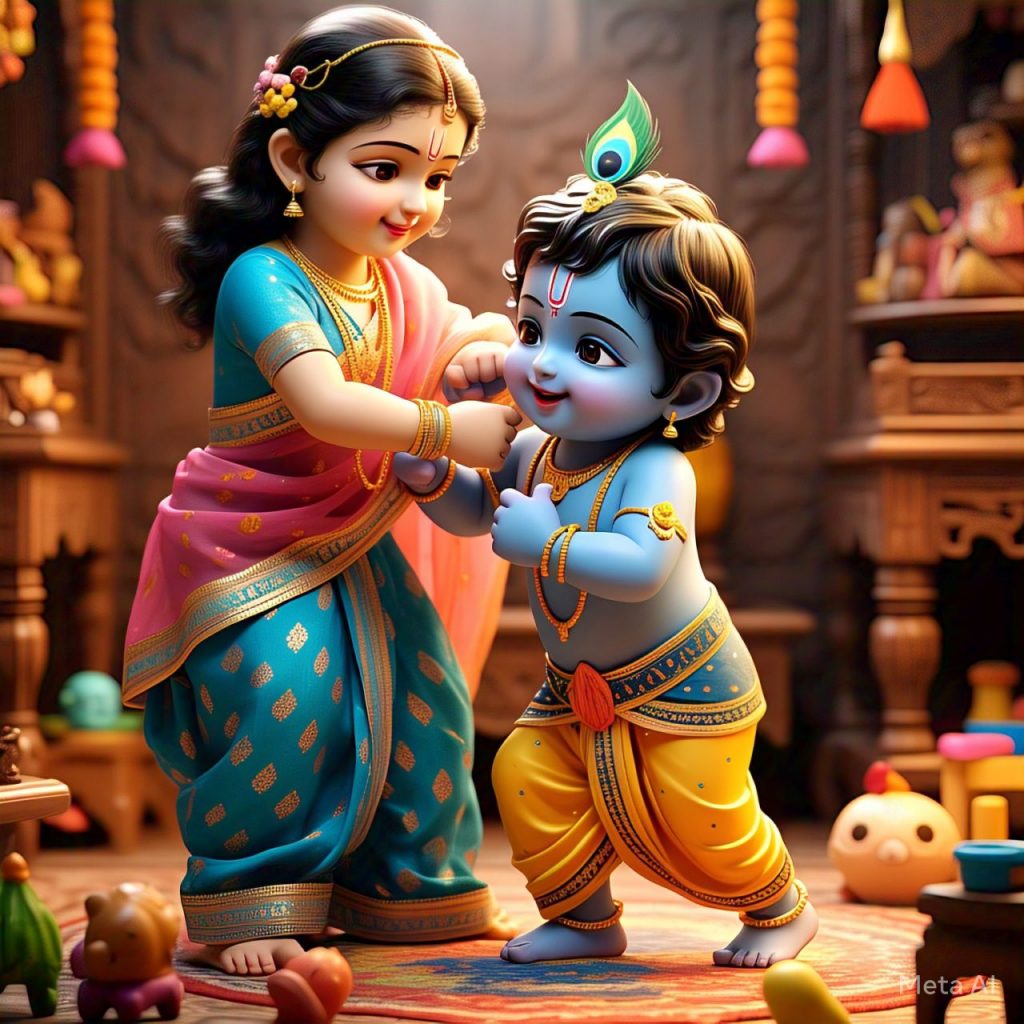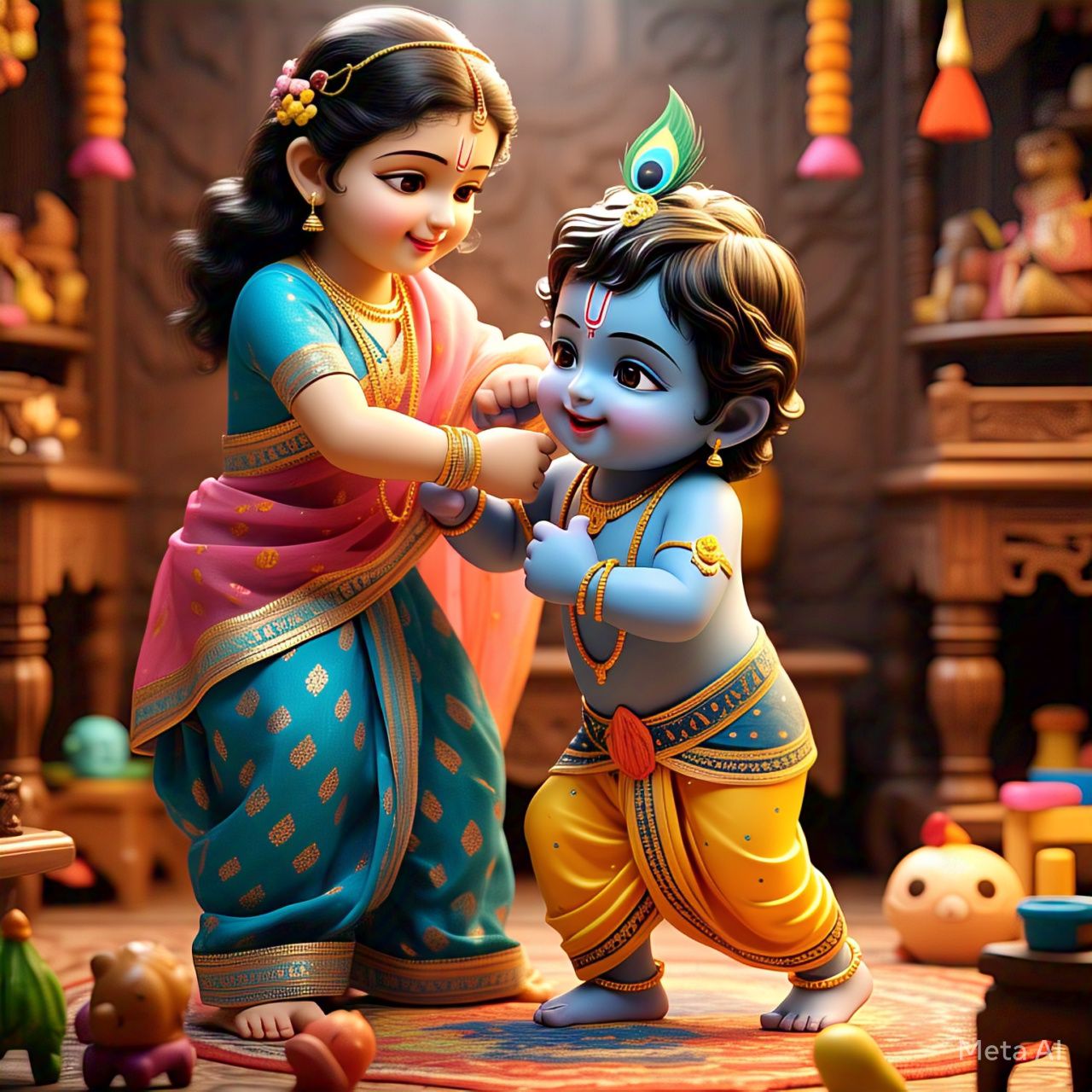
Krishna Janmashtami isn’t just a festival. It’s an emotion. It’s the night when the universe paused to welcome someone who would teach the world about love, leela, and liberation — not by grand sermons, but by living fully, joyfully, and deeply.
There’s something about Krishna Janmashtami. You don’t just worship him, you feel him. In the rhythm of a flute playing far away. In the mischief in someone’s eyes. And especially, in those quiet moments of life — when you are broken, yet smiling — you realize: Krishna has never left your side
The Night the Divine Was Born in Krishna Janmashtami
The story begins in Mathura — a city of pain, oppression, and darkness, under the tyrant Kansa. And in the heart of that darkness, light took birth. At midnight. In a prison cell. No thunder, no storm. Just silence… and then the soft cry of a child.
That child was Krishna.
A baby who would one day lift mountains, dance with gopis, and guide an entire war through his words alone.
But that night — he was just a baby.
As someone who’s always felt close to Krishna, I often imagine that moment. Yashoda maa holding him for the first time. The way her eyes would have welled up. The way she must have smiled even through her tears. Because how do you even hold God in your arms and not fall apart?
The Kanha in Every Home
Every Janmashtami, my house feels like Vrindavan. Strings of yellow marigold hanging above the entrance, butter and mishri as bhog, Krishna’s cradle lovingly decorated with flowers and tiny jhulas placed in every temple corner.
My Nani used to make the smallest footprints with rice flour across the floor — symbolising Krishna’s baby steps entering our home. I believed it, with all my heart. I still do.
At midnight, when we sing “Nand ke anand bhayo, Jai Kanhaiya Laal ki,” I close my eyes and feel him. Not just as a deity — but as a presence. A friend. A confidant. A secret smile during my worst days.
Makhan Chor, Dil Chor
We all know the stories — Krishna stealing butter, teasing the gopis, breaking pots, running barefoot through the lanes of Vrindavan. But what we sometimes forget is why those stories matter.
Krishna teaches us it’s okay to be playful, to be mischievous, to live with lightness. That God doesn’t always sit on a throne. Sometimes, he hides in your kitchen, stealing butter. Or laughs with you when you mess up. Or winks at you through a sudden moment of joy in a hard day.
Kanha is not a god of fear. He’s the god of freedom. Of expression. Of love without condition.
Radha – The Soul’s Song
No Krishna story is complete without Radha. And Radha? She wasn’t just a lover. She was devotion personified.
People often ask, why didn’t Krishna marry Radha? But the real question is — why would he? Marriage is for the world. What they had was beyond it.
Radha represents the soul, Krishna the divine. And their love, the eternal dance between seeker and source. Even today, when you say “Radha,” “Krishna” naturally follows. That’s how deeply they belong.
For someone like me, who often turns to Kanha in silence, Radha’s love feels like my own. That quiet, unshakeable connection — where words aren’t needed, just bhav (emotion) is enough.
“The Story Behind Krishna Janmashtami: How Krishna Killed Kansa”
Kans was a cruel king of Mathura and the maternal uncle of Krishna. He imprisoned his own sister Devaki and her husband Vasudev because of a prophecy that Devaki’s 8th child would kill him.
When Krishna (the 8th child) grew up, he returned to Mathura with his brother Balarama to confront Kans. Kans had planned to kill them by inviting them to a wrestling match against his strongest fighters.
But Krishna defeated all the wrestlers. After that, he jumped onto Kans’s throne, dragged him down, and fought him fiercely.
Finally, Krishna killed Kans with his bare hands, ending his reign of terror and fulfilling the prophecy.
“The Soulful Flute of Lord Krishna on Krishna Janmashtami”
Krishna’s flute isn’t just a musical instrument. It’s a symbol. Of surrender.
The flute has no ego, no barriers. It’s hollow, and that’s why Krishna can play it. That’s what he asks of us too — to become hollow of pride, of doubt, of fear — so he can fill us with his melody.
When I hear flute music during Janmashtami, something stirs inside. A longing. A homecoming. A deep ache, not of pain, but of remembering. As if I once knew that sound, in another life, in another realm, where I too danced by the Yamuna, under a moonlit sky.
Krishna Janmashtami Today — Why We Still Need Krishna
world full of chaos, Krishna reminds us to find leela (play).
life filled with burdens, he shows us the lightness of love.
moments of doubt, his flute still calls us back to who we truly are.
And for those of us who feel broken sometimes, who talk to him in whispers, who look at his little murti and cry when no one’s watching — we know. We know. That Krishna listens. Always.

The Butter, the Battles, and the Bhagavad Gita
Janmashtami isn’t just about the sweet baby Krishna. It’s also about the warrior Krishna. The charioteer of Arjuna. The one who stood in the middle of a battlefield and gave the world the Bhagavad Gita — one of the most profound spiritual texts ever written.
In that moment, Krishna wasn’t just a friend. He was truth, didn’t ask Arjuna to run away from life. He said, “Do your karma. Without attachment. Without fear. With faith.”
That’s why Krishna is so deeply human and so deeply divine at the same time. Krishna laughs, loves. fights. He forgives. He walks with you through every part of life — not just the temples.
“Traditional Outfits Worn on Krishna Janmashtami”
Lord Krishna is one of the most loved gods in Hinduism. He is known for his charming looks, kind heart, and playful nature. The way Krishna dresses is very beautiful and full of meaning.
Krishna usually wears a yellow silk dhoti, which is called “pitambar”. This color stands for purity and positivity. He wears a peacock feather on his crown, which is one of the most special parts of his look. The peacock feather is a symbol of beauty, joy, and nature.
He also wears beautiful jewelry, like necklaces, bangles, and anklets, made of gold and pearls. Krishna’s arms are often decorated with armbands (baajuband), and he wears a tilak on his forehead. Around his neck, he has a vaijayanti mala, a special garland made of forest flowers.
Sometimes, he is shown holding a flute, which is his favorite instrument. Krishna plays the flute to call his devotees and fill their hearts with love.
In his childhood (as Bal Krishna), he is dressed in cute little clothes with ornaments, while in youth (as Kanha or Gopal), he looks like a royal prince with divine charm.
Lord Krishna’s dress is not just beautiful—it also reflects his joyful and divine nature. His appearance brings peace, love, and happiness to all who see him.
